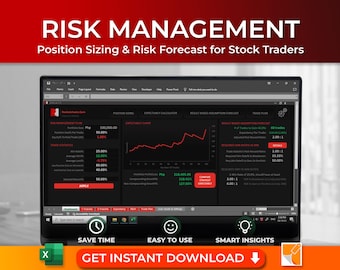Ever heard the joke about the trader who brought a ladder to the stock market? He wanted to reach new heights in position sizing! In the world of day trading, mastering position sizing is crucial for success. This article delves into the fundamentals of position sizing, explaining its significance in risk management and how to calculate the right size for each trade. Discover the impact of account size, leverage, and market volatility on your strategies, and learn best practices to avoid common pitfalls. Whether you're adjusting positions in different market conditions or seeking tools for precise calculations, DayTradingBusiness has you covered with expert insights to help you balance risk and reward effectively.
What is position sizing in day trading?
Position sizing in day trading is deciding how much money to risk on each trade based on your account size and risk tolerance. It determines the number of shares or contracts to buy or sell to control potential losses. Proper position sizing helps manage risk, prevent large losses, and optimize profit potential in fast-paced trading.
Why is proper position sizing important for day traders?
Proper position sizing is crucial in day trading to manage risk and prevent large losses. It ensures you don't overexpose your capital on a single trade, helping preserve your account during volatile swings. Correct sizing allows for consistent gains and reduces the impact of emotional decision-making. It keeps your risk within acceptable limits, making your trading sustainable over the long term.
How do I determine the right position size for each trade?
Calculate 1-2% of your trading capital and use that as your risk per trade. Determine your stop-loss distance in pips or dollars. Divide your risk amount by the stop-loss size to find the position size. For example, if you have a $10,000 account and risk 2% ($200), and your stop-loss is $50 away, then trade size = $200 / $50 = 4 units. Adjust based on volatility and account growth.
What are common methods for calculating position size?
Common methods for calculating position size in day trading include the fixed dollar amount method, where you risk a set dollar amount per trade; the percentage risk method, risking a specific percentage of your trading account on each trade; and the volatility-based method, adjusting size based on the asset's volatility using tools like the Average True Range (ATR).
How does account size affect my position sizing strategy?
Larger accounts allow for bigger position sizes, reducing the impact of each trade’s risk. Smaller accounts require conservative sizing to avoid rapid depletion. Your account size influences how much capital you can risk per trade while maintaining proper risk management. Bigger accounts offer more flexibility but still need disciplined sizing to prevent overexposure. Conversely, small accounts demand careful, smaller positions to stay within risk limits and avoid margin calls.
What role does risk management play in position sizing?

Risk management determines how much capital to allocate per trade, directly influencing position size. It helps limit losses by setting a maximum acceptable risk, ensuring you don’t overexpose your account. Proper risk management guides you to size positions that align with your risk tolerance, balancing potential gains with potential losses. This keeps trading sustainable and prevents large setbacks from single trades.
How much of my capital should I risk per trade?
Risk 1-2% of your capital per trade.
How can I use stop-loss orders to set position size?
Use stop-loss orders to limit potential losses and determine your position size. Set your stop-loss at a level where you're willing to risk a specific dollar amount or percentage of your account. Divide that risk by the distance between your entry point and stop-loss to calculate how many shares or contracts to buy. For example, if you're risking $100 and your stop-loss is $2 away from your entry, buy 50 shares. This ensures your position size aligns with your risk tolerance.
What is the impact of leverage on position sizing?
Leverage amplifies your position size by allowing you to control a larger amount of the asset with a smaller capital outlay. It increases potential profits but also magnifies losses, making careful position sizing crucial to manage risk. Using high leverage without proper sizing can lead to rapid account depletion during adverse moves. Proper position sizing considers leverage to balance risk and reward, ensuring trades remain within your risk tolerance.
How do market volatility and liquidity influence position size?

Market volatility increases risk, so traders often reduce position size to avoid outsized losses during turbulent times. High volatility can cause rapid price swings, making larger positions riskier. Liquidity affects how easily you can enter or exit trades; low liquidity may force you to accept wider spreads or slippage, so smaller positions help manage those risks. In day trading, balancing volatility and liquidity ensures your position size aligns with market conditions, protecting your capital while allowing responsive trades.
What are the best practices for adjusting position sizes during different market conditions?
Adjust position sizes based on market volatility and trend strength. During high volatility, reduce size to limit risk; in stable markets, increase size cautiously. Use ATR or volatility metrics to gauge appropriate sizing. Always align position size with your risk tolerance, risking a small percentage of your capital per trade. Scale down during uncertain or choppy markets, and scale up in clear, trending conditions. Regularly review and adjust position sizes as market conditions change.
How can I avoid overtrading by managing position sizes?
Set fixed percentage limits for each trade, like risking no more than 1-2% of your account. Use stop-loss orders to cap losses on each position. Stick to your predefined position sizes regardless of market excitement. Avoid increasing size after wins or decreasing after losses—maintain consistency. Calculate position size based on your risk per trade and the distance to your stop-loss. This prevents overexposure and keeps trading disciplined.
Learn about How to Avoid Overtrading with Position Sizing
What are the mistakes to avoid in position sizing?
Avoid risking too much on a single trade, typically more than 1-2% of your account. Don't ignore market volatility; adjust size during unpredictable moves. Overleveraging can wipe out your account quickly—use leverage cautiously. Failing to set stop-loss orders or ignoring them increases risk. Using inconsistent position sizes based on emotions instead of a plan leads to poor results. Ignoring your trading plan’s rules on position sizing causes overexposure. Not accounting for slippage and transaction costs skews your position size calculations. Lastly, neglecting to review and adjust your position sizing strategy as your account grows or market conditions change hampers long-term success.
How do I balance between risk and reward through position sizing?
Determine your risk tolerance and set a fixed percentage of your trading capital, like 1-2%, for each trade. Calculate position size based on stop-loss distance to control potential losses. Use smaller positions for volatile stocks to limit risk and larger ones for stable assets with tight stop-losses. Adjust size as your account grows or shrinks, maintaining consistent risk levels. Always prioritize protecting your capital over chasing bigger rewards.
Learn about How to balance risk and reward with stop-loss strategies
What tools or software can help with position sizing calculations?

Tools like MetaTrader, TradingView, and ThinkorSwim have built-in position size calculators. Excel spreadsheets and custom trading calculators also work well. Specific software like MyTraderTool or Trading Journal software often include position sizing features. Online position size calculators, such as those from BabyPips or Investopedia, are quick options. Consider using trading platforms with integrated risk management tools for real-time calculations.
How does position sizing differ between day trading and swing trading?
In day trading, position sizing is smaller because trades are quick, and the goal is to limit risk per trade—often risking 1-2% of your capital. Swing trading allows larger positions since trades last days or weeks, and traders typically risk a bigger percentage of capital per trade, but still manage overall risk carefully.
Learn about How Do Institutional Trading Strategies Differ from Individual Trading?
Conclusion about Best Practices for Position Sizing in Day Trading
In summary, effective position sizing is crucial for successful day trading, influencing risk management and overall profitability. By understanding your account size, market conditions, and employing tools for accurate calculations, you can make informed decisions that balance risk and reward. Remember, consistent practice and adherence to best practices will enhance your trading strategy. For comprehensive insights and tailored guidance, DayTradingBusiness is here to support your trading journey.
Learn about Tips for Consistent Position Sizing in Day Trading